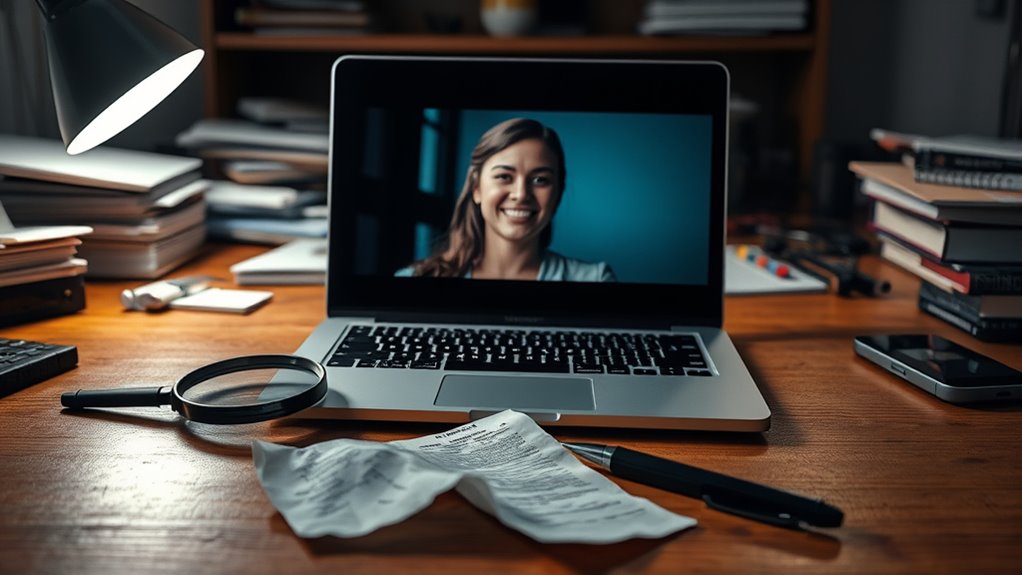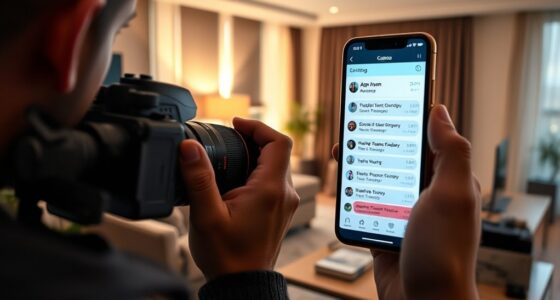Deepfakes and fake receipts are becoming powerful tools for falsely accusing someone of infidelity. These digital manipulations can easily convince others that there’s evidence of cheating, even when there isn’t. This technology can undermine trust and cause real harm. Knowing how to spot these forgeries is essential for protecting yourself. Stay informed about these tricks, and you’ll better understand how to identify and counteract false evidence when it appears.

In today’s digital landscape, deepfakes and fake receipts pose growing threats to trust and security. These sophisticated tools can manipulate images, videos, and documents, making it harder to discern truth from fiction. For individuals, this means your personal life and relationships are at risk of being unjustly scrutinized or falsely accused. Imagine receiving a convincing-looking receipt or a video that appears to show your partner with someone else. Without proper verification, you might doubt your partner’s fidelity or be blindsided by accusations based on fabricated evidence. The danger lies in how easily these fake materials can be mistaken for real, especially when they’re designed to mimic genuine documents or footage flawlessly.
Deepfakes use advanced AI algorithms to create realistic videos or images that depict people saying or doing things they never did. These aren’t just simple fakes; they’re highly convincing, often indistinguishable from authentic recordings to the untrained eye. Fake receipts, on the other hand, can be generated to look like official records—such as credit card statements, transaction histories, or invoices. They are often used to make false claims, support deceitful narratives, or manipulate perceptions. When someone presents a fake receipt as proof of a purchase or an activity, it can instantly cast doubt or create conflict, especially if you’re caught off guard.
The implications for trust are severe. You might find yourself accused of infidelity or misconduct based on fabricated evidence. Once such material is circulated, even if you prove it’s fake, the damage may already be done. These tools can also be exploited in scams, blackmail, or defamation campaigns, making it crucial for you to verify any suspicious evidence before reacting. Relying solely on visual or document proof without cross-checking can lead to false accusations and emotional turmoil. It’s essential to develop a critical eye and seek expert verification when confronted with seemingly incriminating digital evidence.
To protect yourself, always scrutinize the source of any digital evidence and look for signs of tampering. For videos, check for inconsistencies in lighting, shadows, or facial features. For receipts and documents, verify the details through official channels or trusted tools designed to detect fakes. Staying informed about the latest AI-generated content can help you recognize when something might be artificially created. Ultimately, understanding the technology behind deepfakes and fake receipts empowers you to question and verify claims, safeguarding your reputation and peace of mind in an era where digital deception is increasingly sophisticated.
Frequently Asked Questions
How Can Individuals Verify the Authenticity of Digital Evidence?
To verify digital evidence, you should check the source’s credibility first. Look for digital signatures or metadata that confirm authenticity, and cross-reference the evidence with other reliable sources. Use reputable verification tools and consult experts if needed. Be cautious of inconsistencies, such as unusual timestamps or file alterations. Always trust your instincts and verify multiple times before drawing conclusions from digital evidence.
What Legal Actions Exist Against Creating Malicious Deepfakes?
You can pursue legal actions like filing criminal charges for creating malicious deepfakes, especially if they defame, harass, or threaten someone. Laws are evolving to address this, including charges related to cyber harassment, defamation, and fraud. Many jurisdictions now recognize deepfake creation as a criminal offense, and victims can seek restraining orders or civil damages. It is crucial to consult a legal expert to understand your rights and options in your area.
How Do Deepfakes Affect Privacy Rights and Personal Security?
Deepfakes threaten your privacy rights and personal security by making it easy for malicious actors to create false, damaging content. They can be used to spread misinformation, blackmail, or harass you, eroding your trust in digital media. You might also face identity theft or reputational harm if your images or videos are manipulated without your consent. Staying vigilant and understanding these risks helps you better protect your personal information.
Are There Effective Tools to Detect Fake Receipts and Images?
Yes, there are effective tools to detect fake receipts and images. You can use specialized software that analyzes digital signatures, scrutinizes pixel details, and checks for inconsistencies. You can rely on AI-powered verification platforms that compare images against authentic sources. You can trust forensic experts who examine metadata and file histories. You can stay vigilant, question suspicious content, and use these tools to protect your privacy and personal security.
What Ethical Considerations Surround the Use of Deepfake Technology?
You should consider the ethical implications of using deepfake technology, especially regarding consent, privacy, and potential harm. It’s vital to ask yourself if you’re respecting others’ rights and avoiding misuse that could damage reputations or relationships. Using deepfakes responsibly means being transparent about their creation and purpose, and always prioritizing honesty. Remember, ethical use safeguards trust and prevents harm, ensuring technology benefits rather than harms society.
Conclusion
As you navigate the digital world, it’s no coincidence that deepfakes and fake receipts often appear just when trust is most fragile. These technologies can easily manipulate your perception, making false proof seem convincing. Remember, in a time when deception is so accessible, staying cautious isn’t just wise — it’s essential. Coincidences happen, but trust should never be one of them. Stay vigilant, because what seems real might just be a carefully crafted illusion.









